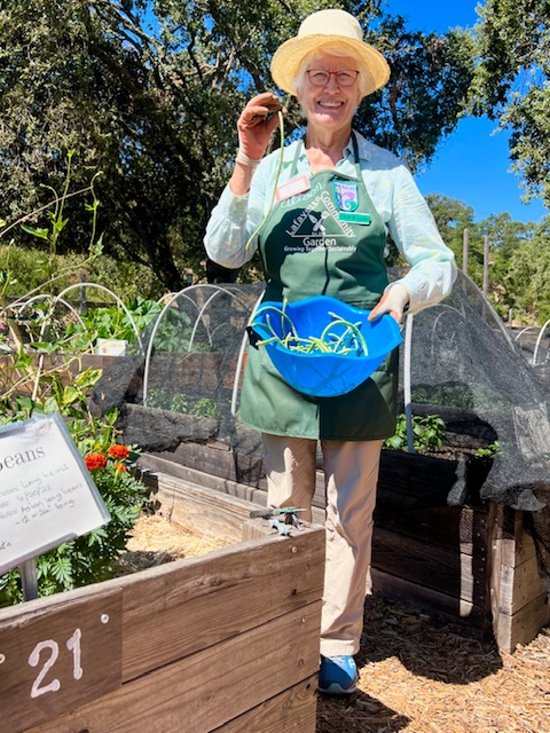| | Published August 31st, 2022
| The story behind one volunteer commissioner with nearly 30 years of service to Lafayette
| | | By Diane Claytor |  | | Alison Hill shows off some long beans growing in the Lafayettte Community Garden. Photo provided |
There are more than 6,700 miles between Lafayette and New Zealand but, according to longtime Lafayette resident, Alison Hill, they are, in many ways, very much alike.
 Having grown up in New Zealand, Hill describes her hometown as a "very outdoorsy place," where she hiked, spent time "out in the wild," and gardened alongside her mother. When Hill and her husband moved to the Bay Area more than 50 years ago, they looked for a similar environment. They found it in Lafayette. "We actually had been looking to buy something in the Oakland/Berkeley hills," Hill recalls. "As hard is as it may be to believe now, Lafayette was more affordable. It was a more modest community back then."
Having grown up in New Zealand, Hill describes her hometown as a "very outdoorsy place," where she hiked, spent time "out in the wild," and gardened alongside her mother. When Hill and her husband moved to the Bay Area more than 50 years ago, they looked for a similar environment. They found it in Lafayette. "We actually had been looking to buy something in the Oakland/Berkeley hills," Hill recalls. "As hard is as it may be to believe now, Lafayette was more affordable. It was a more modest community back then."
 Hill raised two children and worked as a college registrar at several local colleges. She also quickly became involved in her new hometown, doing what she loved most - being outdoors.
Hill raised two children and worked as a college registrar at several local colleges. She also quickly became involved in her new hometown, doing what she loved most - being outdoors.
 She first began volunteering on the Lafayette Parks, Trails & Recreation Commission, serving on the Trails subcommittee; her tenure has lasted almost 30 years so far. As part of their duties, Hill, along with her subcommittee peers, check all the Lafayette trails on a quarterly basis to determine if any maintenance is required. They do minor pruning and cleaning up leaves and look for potential new trails and procure easements, if needed, so trails can be built.
She first began volunteering on the Lafayette Parks, Trails & Recreation Commission, serving on the Trails subcommittee; her tenure has lasted almost 30 years so far. As part of their duties, Hill, along with her subcommittee peers, check all the Lafayette trails on a quarterly basis to determine if any maintenance is required. They do minor pruning and cleaning up leaves and look for potential new trails and procure easements, if needed, so trails can be built.
 Lafayette has seven city-managed trails, plus a trail network in the Community Park, totaling approximately 16 miles of trails. A new trail at the end of Rose Lane and Happy Valley is currently being constructed. Hill hiked this trail in the spring and reports that there were "all kinds of lovely wildflowers up there."
Lafayette has seven city-managed trails, plus a trail network in the Community Park, totaling approximately 16 miles of trails. A new trail at the end of Rose Lane and Happy Valley is currently being constructed. Hill hiked this trail in the spring and reports that there were "all kinds of lovely wildflowers up there."
 She also joined the local Lafayette hiking group, which, at the time, was led by Kay Peterson, who developed the first Lafayette Trails Master Plan. Eventually Hill took over, leading the hiking group for more than 15 years. It was a big job - she created the hikes, deciding what trails to hike, always keeping in mind that her goal was to show people the many trails we have close by. And she always hiked a trail on her own before taking a group. "Even if it's a trail I knew well," she said, "I wanted to make sure a tree hadn't fallen or there hadn't been a slide which could make the hike more difficult or impossible to complete."
She also joined the local Lafayette hiking group, which, at the time, was led by Kay Peterson, who developed the first Lafayette Trails Master Plan. Eventually Hill took over, leading the hiking group for more than 15 years. It was a big job - she created the hikes, deciding what trails to hike, always keeping in mind that her goal was to show people the many trails we have close by. And she always hiked a trail on her own before taking a group. "Even if it's a trail I knew well," she said, "I wanted to make sure a tree hadn't fallen or there hadn't been a slide which could make the hike more difficult or impossible to complete."
 Considering all the trails Hill has hiked, and she says she has hiked just about every one in the area, her favorite in the cooler weather is Mount Diablo and at this time of year, when the weather is warmer, she prefers Briones where there are more shady spots.
Considering all the trails Hill has hiked, and she says she has hiked just about every one in the area, her favorite in the cooler weather is Mount Diablo and at this time of year, when the weather is warmer, she prefers Briones where there are more shady spots.
 Hill also volunteers at the Lafayette Community Garden; her team works on planting and caring for the spring and fall crops. "It's the greatest place with the nicest people," she says.
Hill also volunteers at the Lafayette Community Garden; her team works on planting and caring for the spring and fall crops. "It's the greatest place with the nicest people," she says.
 All of these volunteer roles go hand in hand with what Hill says she loves most: "appreciating nature, noticing plants, birds and wildlife." Her current passion - native plantings - continues along this same line. "As we deal with the drought and climate change, it's so much wiser to have native plants that don't require a lot of water," she states.
All of these volunteer roles go hand in hand with what Hill says she loves most: "appreciating nature, noticing plants, birds and wildlife." Her current passion - native plantings - continues along this same line. "As we deal with the drought and climate change, it's so much wiser to have native plants that don't require a lot of water," she states.
 Her large Lafayette garden has been evolving over the years to now being filled almost totally with native and drought tolerant plants. "In the spring, it's gloriously covered in flowers," she proudly says. "I can sit in my yard and smell the honey from my manzanita flowers."
Her large Lafayette garden has been evolving over the years to now being filled almost totally with native and drought tolerant plants. "In the spring, it's gloriously covered in flowers," she proudly says. "I can sit in my yard and smell the honey from my manzanita flowers."
 Hill taught herself about native planting, with the help of books (one she highly recommends is "California Native Plants for the Garden"); websites (her favorite is bringingbackthenatives.net); and, of course, friends and mentors. "It's a lot of trial and error," Hill admits when talking about what to plant. She claims her philosophy is simple: "If it's too much work or doesn't work, forget it. Find something else."
Hill taught herself about native planting, with the help of books (one she highly recommends is "California Native Plants for the Garden"); websites (her favorite is bringingbackthenatives.net); and, of course, friends and mentors. "It's a lot of trial and error," Hill admits when talking about what to plant. She claims her philosophy is simple: "If it's too much work or doesn't work, forget it. Find something else."
 With autumn approaching, this is the time to start thinking about what natives to plant. A quick online search provides suggestions for hundreds of native plants which would do well in our mediterranean-like climate. Manzanita, penstemon, toyon, vine maple, lupine and California poppy are a few recommended by local gardeners.
With autumn approaching, this is the time to start thinking about what natives to plant. A quick online search provides suggestions for hundreds of native plants which would do well in our mediterranean-like climate. Manzanita, penstemon, toyon, vine maple, lupine and California poppy are a few recommended by local gardeners.
 "You need to work with nature as to when native plants should be planted. They're designed for our climate. The best time to get them in the ground is once the weather starts to cool down," Hill explains. "Cooler weather and hopefully rain will get them off to a good start." They need to be watered lightly for a few years until they are established. After that, they will do what a native plant is expected to do, she says: "Mostly survive on what nature provides."
"You need to work with nature as to when native plants should be planted. They're designed for our climate. The best time to get them in the ground is once the weather starts to cool down," Hill explains. "Cooler weather and hopefully rain will get them off to a good start." They need to be watered lightly for a few years until they are established. After that, they will do what a native plant is expected to do, she says: "Mostly survive on what nature provides."

|
| | | | | | | | | | | | |




